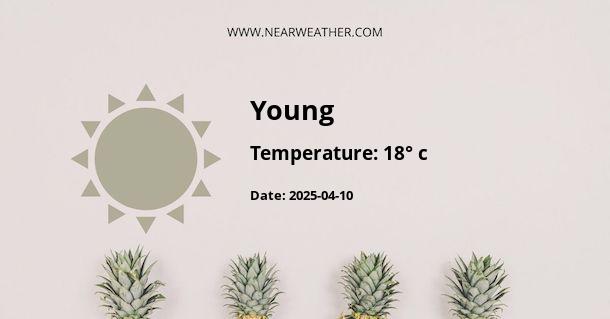Climate and Weather in Young, Uruguay
Youth, Uruguay, located in the South American continent, experiences a temperate climate, characterized by mild temperatures throughout the year. Understanding the climate and weather patterns in Young is essential for residents and visitors alike to plan and prepare for various activities and events.
Annual Weather Overview
The table below provides an overview of the average monthly weather conditions in Young, Uruguay. The data includes average high and low temperatures, precipitation, and humidity levels.
| Month | Average High (°C) | Average Low (°C) | Precipitation (mm) | Humidity (%) |
|---|---|---|---|---|
| January | 31 | 20 | 100 | 75 |
| February | 30 | 20 | 90 | 75 |
| March | 28 | 18 | 80 | 75 |
| April | 24 | 14 | 70 | 75 |
| May | 20 | 10 | 60 | 80 |
| June | 16 | 7 | 50 | 80 |
| July | 16 | 7 | 50 | 80 |
| August | 17 | 8 | 60 | 80 |
| September | 19 | 9 | 70 | 80 |
| October | 22 | 12 | 80 | 80 |
| November | 27 | 16 | 90 | 75 |
| December | 30 | 18 | 100 | 75 |
From the table, it is evident that Young experiences a wide range of temperatures throughout the year, with January being the warmest month and June and July being the coolest months. The humidity levels remain relatively high, varying between 75% and 80% for most of the year.
Precipitation and Seasons
The precipitation levels in Young, Uruguay, contribute to its distinct seasons. The region experiences a wet season and a dry season, influencing the overall climate and vegetation.
The chart below illustrates the average monthly precipitation levels in Young, providing insight into the variation between the wet and dry seasons.

As depicted in the chart, the wettest months in Young are from December to March, with January typically receiving the highest amount of precipitation. Conversely, the dry season spans from May to September, with significantly lower precipitation levels. This distinct variation between wet and dry seasons plays a crucial role in the local ecosystem and agricultural activities.
Microclimates and Local Influences
Young, Uruguay, is known for its diverse microclimates, influenced by its proximity to water bodies, elevation changes, and vegetation cover. The presence of the Uruguay River and its tributaries contributes to localized weather patterns and temperature differentials across the region.
Furthermore, the surrounding topography and land use affect the microclimates in Young. Coastal areas may experience milder temperatures due to maritime influences, while inland areas may exhibit temperature variations based on elevation and land cover, impacting local weather phenomena.
Extreme Weather Events
Although Young generally experiences mild and temperate weather, it is essential to be prepared for extreme weather events that can occasionally occur in the region. These events may include heavy rainfall, thunderstorms, and strong winds, particularly during the wet season. Understanding and monitoring local weather forecasts and advisories is crucial for residents and visitors to stay informed and take necessary precautions when faced with extreme weather conditions.
Conclusion
In conclusion, Young, Uruguay, offers a temperate climate with distinct wet and dry seasons, influencing its overall weather patterns and local ecosystems. The region's microclimates, precipitation variations, and occasional extreme weather events contribute to its unique atmospheric conditions, shaping the experiences of those living in or visiting Young. By understanding the climate and weather year-round, individuals can make informed decisions and preparations to fully appreciate the natural beauty and outdoor opportunities that Young, Uruguay, has to offer.
A - Young's Latitude is -32.683331 & Longitude is -57.633331.
A - Weather in Young is 7° today.
A - Climate Conditions in Young shows clear sky today.
A - Humidity in Young is 53% today.
A - Wind speed in Young is 14.8 km/h, flowing at 232° wind direction. today.
